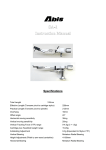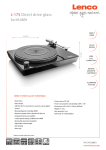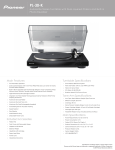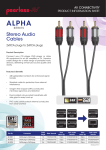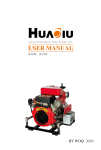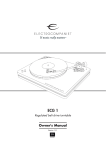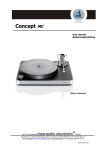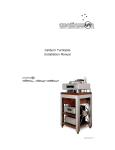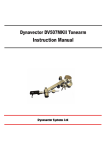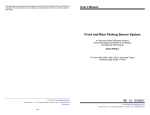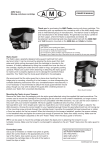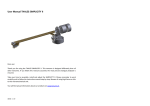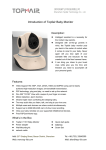Download IKEDA 9: User Manual - Mockingbird Distribution
Transcript
SA-1.2 & SA-1.2B Instruction Manual Specifications Total Length 310mm Effective Length (Tonearm pivot to cartridge stylus) 239mm Practical Length (Tonearm pivot to spindle) 223mm Overhang 16mm Offset angle 22.25° Horizontal moving sensitivity 30mg Vertical moving sensitivity 20mg Vertical Tracking Force (VTF) range 0-4.5g (3+1.5g) Cartridge plus Headshell weight range 15-45g Antiskating Adjustment 0-3g (Equivalent to Stylus VTF) Vertical Bearing Miniature Radial Bearing Horizontal Bearing Miniature Radial Bearing Height Adjustment (Plinth to arm-wand centerline) 15-55mm Output plug RCA (XLR as an Option) Output cable Single core shielded copper Tonearm Audio Lead wire OFC 4N Copper (Internal Wiring) Headshell lead wire Copper with gold plated terminal Headshell Machine tooled Aluminum Tonearm Net Weight 755g Attached standard Headshell Net Weight 17g Included Accessories Headshell Auxiliary counterweight stem Detachable phono cable Screws, Washers and Wrenches Template Marking pin and plastic centering bushing 1) Mounting the tonearm base to turntable plinth a) Determine where the arm base should be mounted by using the supplied arm mounting template. b) Put the larger hole of the template onto the center spindle. Take the attached marking pin supplied (as illustrated below) and push it through the small hole at the opposite end of the tonearm template (the hole opposite the spindle hole). Keep the needle perpendicular to the template. You may now mark the center point of the tonearm base. The center point of the tonearm base is also the pivot point. Arm base Marking pin Template Arm base Turntable Plinth φ22mm Template c) At the same time, mark the 3 holes for the screws that mount the arm base to the armboard. d) Do not drill holes yet ! e) Having marked the center, check to see if there is sufficient clearance for the tonearm and the dust cover (if you have a dust cover). Pay particular attention to the counterweight shaft. f) After you have verified the dust cover will work with the chosen arm base location, drill one 22mm hole (this is the center, which allows access to the tonearm stem and cable) and three 3.5mm holes (for the screws that mount the arm base). 22mm diameter hole: For tonearm shaft! 3 x 3.5mm diameter holes: For tonearm base fixing screws! 2) Attach the cartridge to headshell Connect the wire leads to the cartridge pins, and attach the cartridge to the headshell with screws. (See the figure below) Screws are not included in this tonearm kit. They are usually included with the cartridge, from the cartridge manufacturer. 3) Mount SA-1 shaft through the base hole a) Carefully push the tonearm shaft through the hole in the arm base and then fasten the set-screw with the hex key supplied with the tonearm. Be careful not to over tighten! b) Adjust the tonearm height to make the tonearm parallel with the surface of the record when the stylus is touching the record. This is the starting point, and further fine tuning may be necessary, depending on the geometry and the stylus type of the cartridge. Consult the cartridge manufacturer for correct VTA and VTF! c) The cueing platform has already been set at the correct height but can be adjusted by using the supplied hex key. 4) Cartridge tracking force adjustment a) Verify that the anti-skating knob (number 3 below) is set at 0 grams. b) Ensure that the sliding tracking force adjustment knob (number 4 below) is set to zero (the point furthest to the back of the tonearm and closest to the pivot point). c) After the cartridge is correctly adjusted for overhang, adjust the counterweight (number 1 below) so that the arm is floating with the stylus approximately 3-5mm clear of the vinyl record. Once this adjustment is made, the counterweight should be fixed by the set-screw located on the side of the counterweight (number 2 below), using the supplied hex key. d) Add tracking force by using the sliding counterweight located in the middle of tone arm (number 4 below). As the middle counterweight slides forward, the tracking force increases. The tracking force can be increased to a maximum of 3.0 grams with the middle sliding counterweight pushed all the way forward to the headshell end of the tonearm (each step is equivalent to 0.5 grams x 6 steps, making 3 grams). e) The auxiliary weight is 1.5 grams (see 5 below). If more than 3 grams of tracking force is needed, as might be the case when playing 78 rpm records, place the ancillary weight in the hole as illustrated in the drawing (see 5 below). Only use this auxiliary weight if additional tracking force is needed! If it is not needed, store it away in a safe place. 1 5 2 4 3 Example: If the tracking force needed is 3 grams, set the middle sliding counterweight at the mark for 3 grams on the weight gauge. If more than 3 grams of tracking force is needed, use the auxiliary weight of 1.5 grams, along with the counterweight, in order to secure your desired tracking force. For instance, the ancillary weight of 1.5 grams, plus 2.5 grams of tracking force set by the middle sliding counterweight, is equivalent to 4 grams total tracking weight. Note: Because the tracking force mechanism (#4 above) of SA-1.2 is different from a standard counterweight system, the use of a separate VTF gauge for precise fine-tuning is recommended. The relative accuracy of the SA-1.2 tracking force mechanism is somewhat affected by the complex interaction of the mass of the main counterweight, its position, the mass of the cartridge, and the mass of the headshell. So, as is usual with all tonearms, you should verify the desired tracking force with a calibrated VTF gauge. 4) Auxiliary counterweight stem In case the standard counterweight is not heavy enough to balance your cartridge/headshell combination, an additional counterweight stem has been supplied to give additional mass, and greater range of adjustment. a) Remove the counterweight and headshell, setting them aside in a safe place. b) Inspect the threads on the auxiliary counterweight stem. If there is any debris, please brush it with a small paint brush, or clean toothbrush. Debris can cause the threads to become stuck. c) Attach the auxiliary stem by carefully threading clockwise into the main stem. The threads are normal “right-hand threaded”. d) Tighten firmly with your fingers, but do not apply aggressive force. Do not use a wrench, or other tool that would apply too much force on the bearings. Do not use thread-locking compound (removal would require excessive force). Finger-tighten only! e) The auxiliary counterweight stem provides two methods of counter-balancing heavier cartridges and headshells. (1) The weight of the auxiliary stem provides additional force. (2) The stem also provides much greater range of adjustment of the main counterweight (the zeroset counterweight). 5) Anti-skating (bias) adjustment a) Set the bias adjustment knob to the same number as the tracking force. Some experimentation may be necessary based on the specific stylus profile used by the cartridge. Sibatech Tokyo, Japan





